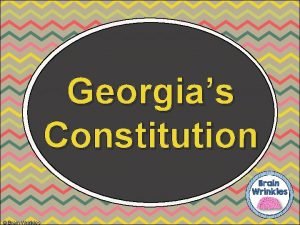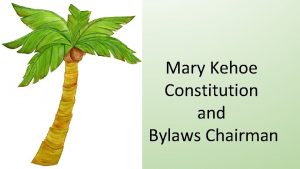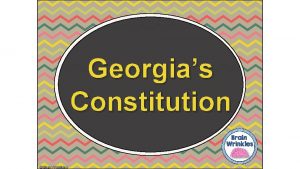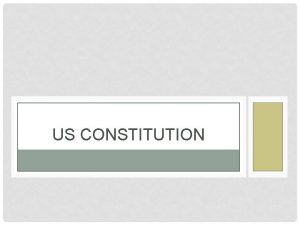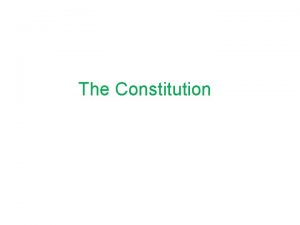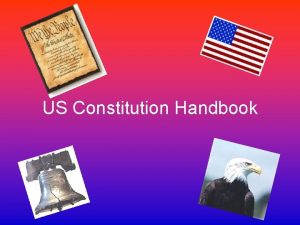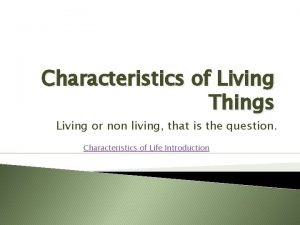THE LIVING CONSTITUTION ASSESSMENT U S Constitution in

























- Slides: 25

THE LIVING CONSTITUTION * ASSESSMENT

U. S. Constitution in your book, page 82 Assessment, page 106

Article 1 – Legislature National legislature is called Congress Two houses �Senate – equal representation, 2 members from each state �House of Representatives – proportional representation, now for about every 600, 000 people (Texas has 35 representatives)

Article 1 – Legislature 1. Why does the legislative branch more directly represent the people? A. Think of how branches are selected B. Senate is now directly elected, every 6 years C. House of Representatives is directly elected – whole House, every 2 years

Article 1 – Legislature 2. Why more Representatives than Senators? Answer – House is proportional, “based on population, ” while each state has only 2 senators.

Article 1 – Legislature 3. Name four powers of Congress. Answer – See Section 8 of Article I (page 88) – it lists 18 “enumerated” powers of Congress. List 4. Tax, borrow money, regulate commerce, coin money, establish post offices, create federal courts, declare war, raise an army, make laws

Article 1 – Legislature 4. What powers are denied to Congress? Can’t suspend habeas corpus, illegally punish people, levy direct taxes, levy export taxes on goods from any state, take money from treasury illegally, issue titles of nobility (no kings in America) Denied to states? States cannot enter treaties, coin money, levy import/export taxes, wage war on their own.

The Constitution Article II – The Executive Branch (President)

Article II - Executive 5. Main function of the executive branch? Answer: To carry out the laws made by Congress Also – to conduct foreign policy Must follow the Constitution

Article II - Executive 6. Who officially elects the president? Explain Answer: The Electoral College selects the president, by vote of the states’ electors (see Article II, section 1, paragraph 2 – page 90) Electors are elected by people in the states

Article II - Executive 7. How can the president lose her/his job before the next election? Answer: Impeachment, as listed in the Constitution. Also – death (which the Constitution anticipated) or resignation (which the Constitution does not mention) Two other ways, in elections: Does not run for re-election, or defeated for re-election

Article III - Judiciary 8. How are Supreme Court Justices appointed? Answer: See Article II, Section 2, “Treaties and Appointments” (page 91) The president nominates federal judges, “with the advice and consent of the Senate” In practice, president nominates, Senate confirms Note: There are nine Supreme Court justices; they serve for life, or until they retire

Article III - Judiciary 9. What kinds of cases does the Supreme Court hear? Why is their decision to hear a case important? Answer: Generally, they hear appeals of cases from the lower federal courts – a decision not to hear a case means the lower court’s ruling stands, with no further appeal

Article IV – The States 10. Extradition, means to send a prisoner to another state for trial. Why is this an example of state relations? It exemplifies (is a good example of) cooperation among the states Other ways states cooperate: State compacts on river management; State cooperation on commercial laws

Article V - Amendment 11. How many states does it take to ratify an amendment? Why that many? It takes ¾ of the states (we have 50 states; ¾ is 75%, or 38 states when rounded to the whole number) So many states are required to make amendment difficult, to show the gravity of amendments (gravity=“seriousness” or “importance”)

Article VI - Supremacy 12. How does Article VI establish supremacy of the Constitution? ANSWER: It makes the Constitution “the supreme law of the land” All laws at every level of government must uphold the Constitution Nota bene: Article VI also contains a ban on religious tests for any office

Amendments 13. Does the First Amendment allow complete freedom of speech, the right to say anything you want, any time, any where? Explain ANSWER: No, there are limits – you can’t yell “FIRE!” in a crowded theatre, for example, because that causes panic and people could die. We do not have the right to slander or libel freely, either

Amendments 14. What is the newest amendment? What protection does it give to the American people? ANSWER: The 27 th Amendment is the latest amendment; it prevents members of Congress from using taxpayers’ money for their own gain

The Constitution A few further notes on Amendments

Civil War Amendments Amendment 13 – abolishes slavery Amendment 14 – Civil Rights – expands rights of citizens to everyone native or natural born, including rights against states; expands due process rights Amendment 15 – Expands protection of right to vote to all citizens regardless of race, color, or “previous condition of servitude” (slavery)

Prohibition and repeal 18 th Amendment gave states the right to ban the manufacture and sale of liquor and alcoholic beverages – ratified in 1919 21 st Amendment repealed Prohibition, repealed the 18 th Amendment, December 5, 1933 This is the only amendment to have been repealed

Women’s Suffrage (Right to Vote) 19 th Amendment says no state nor the federal government may prohibit women from voting because they are women Note “suffrage” means “right to vote, ” and has nothing at all to do with suffering

The end. Thank you THE LIVING CONSTITUTION * ASSESSMENT


 Texas constitution vs u.s. constitution venn diagram
Texas constitution vs u.s. constitution venn diagram Nc constitution vs us constitution
Nc constitution vs us constitution Constitution what is constitution
Constitution what is constitution Lesson 1 principles of the constitution
Lesson 1 principles of the constitution Venn diagram of living and non living things
Venn diagram of living and non living things Yeast living or nonliving
Yeast living or nonliving Living non living dead
Living non living dead Smallest living unit
Smallest living unit Activities of daily living assessment
Activities of daily living assessment Hát kết hợp bộ gõ cơ thể
Hát kết hợp bộ gõ cơ thể Frameset trong html5
Frameset trong html5 Bổ thể
Bổ thể Tỉ lệ cơ thể trẻ em
Tỉ lệ cơ thể trẻ em Gấu đi như thế nào
Gấu đi như thế nào Tư thế worm breton
Tư thế worm breton Chúa yêu trần thế
Chúa yêu trần thế Môn thể thao bắt đầu bằng từ đua
Môn thể thao bắt đầu bằng từ đua Thế nào là hệ số cao nhất
Thế nào là hệ số cao nhất Các châu lục và đại dương trên thế giới
Các châu lục và đại dương trên thế giới Công thức tính thế năng
Công thức tính thế năng Trời xanh đây là của chúng ta thể thơ
Trời xanh đây là của chúng ta thể thơ Cách giải mật thư tọa độ
Cách giải mật thư tọa độ Làm thế nào để 102-1=99
Làm thế nào để 102-1=99 Phản ứng thế ankan
Phản ứng thế ankan Các châu lục và đại dương trên thế giới
Các châu lục và đại dương trên thế giới Thơ thất ngôn tứ tuyệt đường luật
Thơ thất ngôn tứ tuyệt đường luật


























